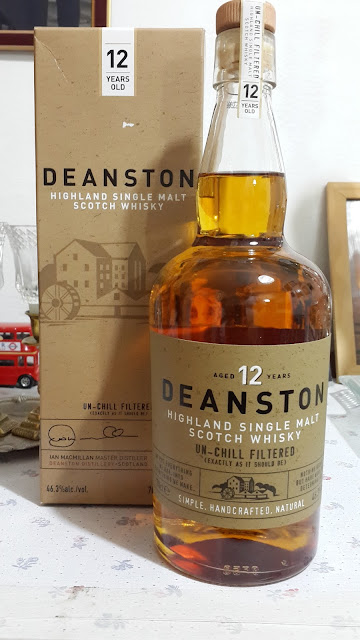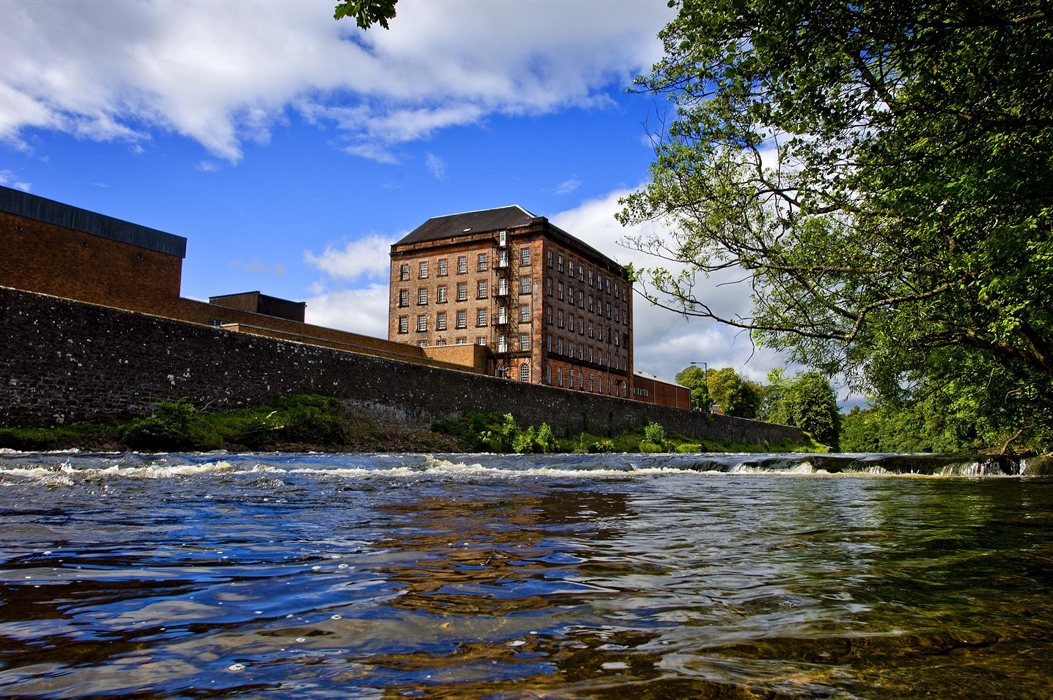Deanston 12-Year-Old review
Deanston distillery was established in 1965 but the building
in which it is housed was originally an old 18th century weaving mill.
Despite Deanston’s relatively young age, if you visit the excellent visitor's centre, you will see that the distillery retains that “Oldy Worldy” By-Gone-Days ambience. Its sole purpose of existence was to produce anonymous whisky
to go into various blends. Then the great whisky slump of 1982 arrived and
Deanston was unceremoniously closed along with many other distilleries that
year. Its future looked bleak and it was not expected to reopen.
Then, Burn Stewart Distillers, Glasgow came to the rescue
and bought it in 1990. Burn Stewart set about (just as they had for
Bunnahabhain on Islay and Tobermory on the Isle of Mull), turning Deanston into
a craft product style distillery. They
set about manufacturing single malts using traditional methods, packaging with
simple environmentally friendly boxes and bottling at higher strength,
non-chill-filtering and natural colour. If they do use a computer at the distillery, it was probably built by Charles Babbage.
Deanston boasts one of the last remaining operational open top mash tuns. The only other place I know which still uses them is Bruichladdich. I’m surprised this type of mash tun has not been banned by 21st century Hygiene and safety regulations.
Deanston boasts one of the last remaining operational open top mash tuns. The only other place I know which still uses them is Bruichladdich. I’m surprised this type of mash tun has not been banned by 21st century Hygiene and safety regulations.
Today the Deanston range begins with the entry level No-Age-Statement single
malt “Virgin Oak”, (actually matured in Ex-Bourbon hogsheads but finished in charred
Virgin Oak), which costs the same as the ubiquitous Chivas Regal 12-Year-Old Premium Blend,
found on the shelf of almost every Israeli who has ever passed through an
international airport who buys this sweet syrupy Blend like a mindless drone.
The “Virgin Oak” on the other hand, is a superb introduction to “real” whisky – Single Malt,
giving you so much more for your £30. I hope to be reviewing this in the near
future.
Their house-style standard single malt, which we will be reviewing
below, is the 12-Year-Old. They also do an Organic 14-Year-Old, unfortunately sold
exclusively in the United States. Their premium whiskies are the 18-Year-Old
Bourbon Finish (reviewed by me here), and the sherry cask matured 20-Year-Old, (which we won’t
be talking about).
Deanston 12-Year-Old. Bottled at 46.3% abv, Non-Chilled-Filtered,
Natural Colour. Price NIS 250, £40 in the UK.
Looking back on my review of the Deanston 18, perhaps I was
a bit harsh in my assessment of this distillery and its whisky. I have since
gone back and amended my review. I really
should not have disparaged this distillery which after all, is one of only a select
few which valiantly insist on bottling without artificial colouring, do not
chill filter their whisky and do bottle at the standard Burn Stewart higher
strength alcohol level of 46.3% ABV.
I however have not changed my opinion about the very high priced 18-Year Ex-Bourbon finish which I criticized for, in my opinion, tasting more like a descent American Straight Bourbon costing a third of the price and managing to lose any semblance of a Malted Barley character which after all, is the definitive flavour character of Scotch Single Malt.
I however have not changed my opinion about the very high priced 18-Year Ex-Bourbon finish which I criticized for, in my opinion, tasting more like a descent American Straight Bourbon costing a third of the price and managing to lose any semblance of a Malted Barley character which after all, is the definitive flavour character of Scotch Single Malt.
The question is, what happens when the same distillery
produces a whisky which is also matured in American Ex-Bourbon oak casks, but
matured in those barrels for only 12 years with no final super-active cask
finishing? Oh, and no less important, about half the price!
Packaging
Here in Israel, like in the United States, they sell
Deanston expressions in environmentally friendly recycled paper beige and brown
cardboard boxes with simple labels and a paper strip barely covering the cork.
I personally do not like this style. It seems as if the marketing department in
the UK agree with me as the same expression is sold in Britain in regular foil
rapping around the cork and enclosed in a much more conventional but rather
stylish canister.
 |
| 12-Year-Old UK Bottling |
Nosing
I poured my guests and then myself a dram, adding a few
drops of water to the Glencairn glasses. Swirling the liquid around the glass
produces lovely thick legs of alcohol which stick to the inside of the glass.
Bringing the whisky to my nose, what immediately strikes you
is the lovely malted Barley grain like creamy digestive biscuit with rich
polished new wood smells. Like the Tomatin 15 (which I reviewed two weeks ago),
as well as the Glencadam 10, this southern Highlands single malt might seem at
first impression to lack complexity. However, one must not make the mistake of
confusing a lack of complexity with crystal clear clarity of the different
aromas coming through on the nose. This
whisky shows multifaceted aromas but all are distinct and discrete like looking
at the smelling equivalent of a perfectly focused photographic image.
Take your time with this Deanston. There is some kind of very
pleasant light musky perfume. I know nothing about perfume so cannot identify
it. I will have to ask my daughter (who is far better at recognising these aromas than I am), to
see if she can identify a particular perfume.
This Deanston may not have the complex layers of an Islay
whisky but nevertheless shows an inherent palpable quality which is very
invigorating. In music terms, it’s like spending your time listening to a heavy
Bruckner symphony, trying to identify all the orchestral sections and then,
switching to an acoustic album such as the superb 1987 “Red Dust And Spanish
Lace” album by “Acoustic Alchemy” on vinyl (of course!).
In Torah terms, it is like struggling with a richly
rewarding Rav Shlomo Kluger perush on the parsha and then switching to Chumash
with Rashi. As satisfying as Rav Shlomo Kluger’s perushim are, there is
something refreshing about going back to a Rashi. You are immediately awe
struck by the beauty of simplicity! Most Jewish children grow up learning Rashi
with Chumash and may make the mistake in later years of overlooking the subtle
depths of his comments.
The nosing reveals sweet wood charred smoke and raw
honeycomb on buttered wholemeal toast. Luscious malty cereal biscuit and sour tart
fruit cocktail are most dominant though.
(Just to be clear, I don’t mean the honeycomb confectionary
you get by the seaside in England, I mean the real, made by bees, honeycomb).
There is a sweet smell of white sherry, burnt sugar glazed
almonds with a touch of cinnamon and wood spice. A hint of slightly underdone
fresh bread, straight out of the oven and waxy wood spices.
Smelling this whisky brought back a childhood memory of
opening up my parents’ cocktail cabinet.
My mother’s grandfather was a cabinet maker and owned a
factory in the East End of London. We don’t know if my great grandfather
actually made this beautiful antique cabinet himself but it was certainly made
in his factory.
Mouth Fill and initial tasting.
As the nosing indicated, there is a full mouth fill with
creamy malted barley. In fact, this is one of those whiskies (like Glencadam 10
and 15) where you can really notice the difference in mouth fill between a
chilled filtered whisky like Tomatin 15 or Dalwhinnie 15 and a Non-Chilled
Filtered Single Malt. The liquid sits there in the mouth and you can feel the
substance and body through the natural oily malted cereal flavours.
Underneath the barley cream there is the taste of pebbles
from a stream. Raw natural sour honey and barley sugar sweets. There is a lovely
fruitiness with the texture of apple, sultanas and cinnamon crumble. It does
not have an amazingly long finish, (the Glenrothes Alba Reserve was superb) but
maintains a clean natural malted barley taste in the mouth to the very end.
Friday Night Tasting
On Friday night, I invited my family and a friend to taste
this Deanston and have recorded their Tasting notes here.
A good friend of mine said that it reminded him of new
polished leather, sweet spices with dried apples.
I remarked that I agreed with him that there was definitively
apple but more like Toffee apples. (Apples on a stick, dipped in brittle
toffee; not the Chinese fried versions).
My son said it reminded him of apple and cinnamon yeast
cake.
My wife said it smelled of vanilla yogurt and vanilla and
caramel spiced tea.
Conclusion
The Deanston 12 maintains an excellent balance of malted
barley and Bourbon cask influence which translates into a more enjoyable
and satisfying whisky than its older brother the 18-Old, and certainly offers much better
value for money! Why, you could even go out and buy a bottle of
descent Straight Bourbon and a bottle of Deanston 12 and you will still spend
less money than the bottle of 18-Year-Old.
What I really admire is the distillery's dedication to craft
presentation and its style of packaging. Along with its lack of reputation, it will not appeal to the Glenlivet/ Glenfiddich crowd. It does however have everything which a single malt whisky purist is looking for and it’s all at a very
affordable price. To get a natural colour, NCF and higher than 40% abv from the
popular single malt brands you will have to pay a lot more than the price
of this Deanston 12. Given the choice of say, The latest Glenlivet Nadurra First Fill NAS and this, I'd go for this Deanston every time.
Deanston is a whisky which is still very much under the
radar. It deserves better popularity. This 12-Year-Old should be a must have in
every malt whisky collection.













Comments
Post a Comment
--------------------------------------------------------------------------------
Please enter your comment above this line, and then click on the PUBLISH button (on the far right hand side).